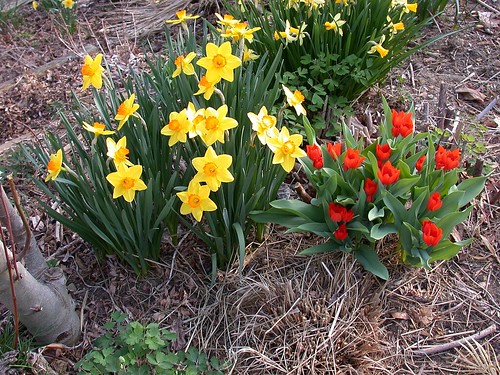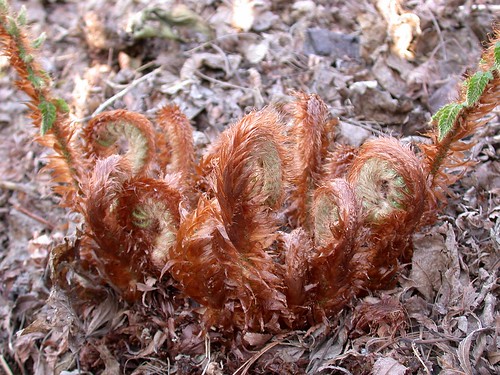
"Why does our neighbor's garden look better than ours?" These are words that, coming from one's spouse, will make any self-respecting gardener wince. And it's true, this time of year I'm a bit jealous of the daffodils and tulips blooming in the garden next door, and the perennials that are practically filled in already. Their garden is lush and green, and mine kinda looks like crap.
I'll be the first to admit that my garden looks like hell in the winter and spring. Because of my emphasis on perennials, annuals, and heat-loving tropical plants, much of the garden dies back in the fall and frankly, I don't bother to clean it up until the following spring. I'm of the philosophy that all that organic matter, left in place to decompose, helps improve the soil. (At least that's what I tell myself; maybe I really am just that damn lazy.) It doesn't help that after our coldest winter in 20 years, many normally evergreen plants that would otherwise look good right now--for example bamboos, fatsias and hardy palms--are looking pretty sad. Most of these will recover, but it will take some time.

As much as I love them, I use spring-flowering bulbs rather sparingly. Daffodils are wonderful for early spring color, but in my climate the flowers rarely last for more than a few days, whereas the foliage remains for weeks afterwards, taking up space and demanding sun if they are to bloom again next year. Tulip foliage fades faster, but the flowers are likewise ephemeral. And then there's the problem of digging up dormant bulbs anytime I decide to plant something in late summer or autumn.
I do have some plants coming up and getting ready to bloom, like bleeding hearts, bearded irises and columbine, but these spring-flowering perennials tend to look a bit ratty by mid-summer. In a small garden like mine, plants have to earn their keep by looking halfway decent throughout the growing season, even when they're not blooming. Many early-blooming perennials can't pull their weight by late summer, so I try to limit these to just a few of my favorites. Meanwhile many of the later-blooming perennials like Asclepias tuberosa, Spigelia marilandica, Hibiscus hybrids, and Begonia grandis, are barely emerging from the ground. In part because of this, and in part because I reserve space to try new annuals or tropicals every year, there are many gaps right now.
Perhaps most glaringly, the landscape timbers that were used to terrace the hillside, probably 20 or more years ago and never installed properly, are rotting and failing. Yes, they look terrible. I've known for years that they need to be replaced, but again, I'm just that lazy. Anyway, once everything starts growing, they are completely invisible... and this time of year, things grow very, very fast.

It's easy to convince people you have a wonderful garden when you only show photos of it at its peak--which for some gardens is just a week or two in the spring. I'm not afraid to show my garden at its absolute worst, because once I get everything cleaned up and planted--usually sometime in mid-May--I'm pretty pleased with it. If anything, the before-and-after photos are that much more dramatic. So when does my garden look good? From early summer well into the fall, sometimes even into early December, depending on when our first killing frost comes around. At a time of year when many other gardens are fading and tattered, mine is still going strong.
So this weekend I'll do a bit of cleanup, cutting back obviously dead stems and foliage, but otherwise I'm not in any hurry to do much in the garden. I'm content to hold off for a bit, because I'm still waiting to see what survived and might still come up, and it's too early to plant out the begonias, cannas, and other plants I'll grow this year. There are other pleasures to be had, whether it's the fern croziers unfurling, or an evening rainbow over the neighborhood. Maybe I'll get more work done in the garden next weekend.


Gardens meet the purpose of the gardener! No shame, no blame - I am not a neat freak either and I like having seasonal rest to think and plan and watch a day go by!!
ReplyDeleteThanks Rick, just about my favorite weekend afternoon is "puttering" in the garden, not really doing much except looking at plants and daydreaming. And at the end my garden is weeded and I have no recollection of doing so!
DeleteNot really sure what style of garden or climate is preferable, but it sounds like you enjoy yours at the key seasons you prefer it at its best. I get spoiled having a year round growing season, but actually am in conflict with the local climate, because summer/early fall, natives here are mostly dormant due to a 7 month dry season. So one has to irrigate, not all that politically correct in a sustained drought. I too enjoy lushness in late fall, but that easily extends into spring here, with so little frost in an average winter. Time I save withleaving stuff in the ground is quickly expended with year round pruning and weeding, but no complaints here. DC really can look and feel tropical in the hot months, too much heat and humidity for me! David in Berkeley
ReplyDeleteDC definitely feels like a tropical climate in the summer, and tropical plants do very well as warm-season plants here, hence my blog name! But I do like the changing of seasons, and I like having the winter to rest and plan/dream a bit. I do nearly all of my garden work in a few short weeks in the spring, and even less in the fall--by the end of May the heat and humidity, along with mosquitoes, make garden work nearly impossible.
DeleteYou know, in our classes we are told that dead matter left remaining helps the soil structure. And then we are told dead matter holds disease and fungus over winter. What's a gardener to do?
ReplyDeleteRay
I'm absolutely convinced that our gardens benefit from organic matter, and anytime we put that stuff out in the trash we are stealing from our own garden. I'm definitely ambivalent about the pest/disease angle but I've been saving all my trimmings, dead stuff, etc. for years and the only serious problem I've had is spider mites on crocosmia. Otherwise I've had virtually no pest or disease problems (knock on wood!).
DeleteGardeners tend to put too much pressure on themselves it's easy to forget that gardening can be relaxing :)
ReplyDeleteOh believe me, I can relax! Mostly in the summer when it's too hot, humid, and buggy to do much anyway. But the work itself is surprisingly relaxing; when I work in the garden it pushes all worries, cares and concerns out of my head. (Except of course for the garden-related ones like "how many more years can I put off dividing that Miscanthus?" or "where on earth am I going to put all these plants I just bought on a whim?")
DeleteI know how you feel all too well! My garden looks kind of dreadful for about two months after I cut it all back in February. It's really just now starting to look like a garden again. I have the same feeling about many early-spring bloomers...they just look awful once summer hits (or even worse, go dormant). Even now, the Tulips are finishing up and the foliage just looks terrible and I want to yank it all out...but can't or I sacrifice blooms next year. Sigh!
ReplyDeleteComing from upstate New York, it was a bit of a shock to find so many of my favorite plants are poor choices here. I finally gave up on siberian irises because they bloomed for all of 3 or 4 days for me and the foliage just didn't hold up well. (I'm tolerating the bearded irises because they have a slightly longer bloom period.) I yanked out all the (herbaceous) peonies planted by previous owners because they always flopped and I just hate staking or hooping anything. Oriental poppies? Giant rat's nest that goes summer dormant but you can't fill the space with anything because it comes back! I'm learning to embrace the heat and humidity (and long growing season!) and to use plants that like those conditions, and looking more to the southeast than the northeast for inspiration.
Delete